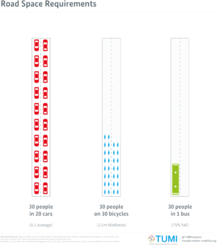
Back Verkehrsmodell (Verkehrsplanung) German Modelización de transporte Spanish Liikenne-ennuste Finnish Ramalan transportasi ID Transporto srautų prognozavimas Lithuanian Verkeersmodel Dutch

Transportation forecasting is the attempt of estimating the number of vehicles or people that will use a specific transportation facility in the future. For instance, a forecast may estimate the number of vehicles on a planned road or bridge, the ridership on a railway line, the number of passengers visiting an airport, or the number of ships calling on a seaport. Traffic forecasting begins with the collection of data on current traffic. This traffic data is combined with other known data, such as population, employment, trip rates, travel costs, etc., to develop a traffic demand model for the current situation. Feeding it with predicted data for population, employment, etc. results in estimates of future traffic, typically estimated for each segment of the transportation infrastructure in question, e.g., for each roadway segment or railway station. The current technologies facilitate the access to dynamic data, big data, etc., providing the opportunity to develop new algorithms to improve greatly the predictability and accuracy of the current estimations.[1]
Traffic forecasts are used for several key purposes in transportation policy, planning, and engineering: to calculate the capacity of infrastructure, e.g., how many lanes a bridge should have; to estimate the financial and social viability of projects, e.g., using cost–benefit analysis and social impact assessment; and to calculate environmental impacts, e.g., air pollution and noise.
- ^ "Creation of one algorithm to manage traffic systems. [Social Impact]. ITS. The Intelligent Transportation Systems Centre and Testbed". SIOR, Social Impact Open Repository.
© MMXXIII Rich X Search. We shall prevail. All rights reserved. Rich X Search